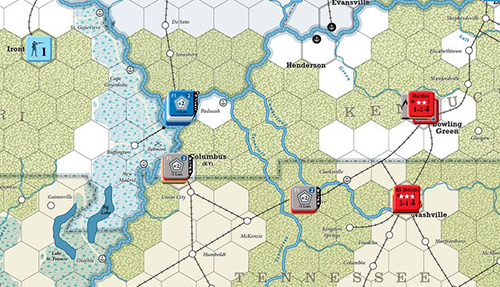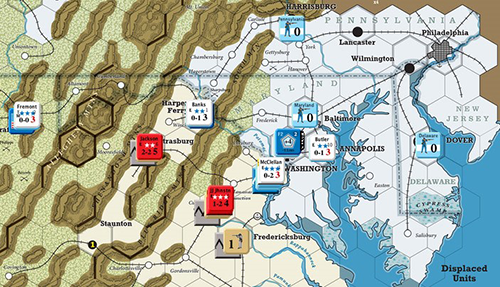The U.S. Civil War Review
on Apr 27, 2016
The dearth of strategic level American Civil War games is testament to a daunting design task. Not only is it extremely difficult to portray the war on the tabletop, but designers who venture into the time period are seemingly pre-ordained to disappoint. Simulating such one-sided affairs is easy, but often difficult to create a game about that is entertaining. GMT’s ambitious attempt, helmed by veteran wargame designer Mark Simonitch, is humbly titled The U.S. Civil War. With a sprawling two-board map, dozens of charts and tables, hundreds of counters and a 40-page outlined rule book. You immediately realize you’re in for hours of game play.
Mr. Simonitch doesn’t set out to reinvent the wheel. His The U.S. Civil War (TUSCW) instead borrows almost all of its elements from previous titles. In most cases he takes the better concepts from those predecessors and improves upon them with logical tweaks that make historic sense, adding original rules and ideas for a somewhat fresh creation, yet in the end not compellingly unique.
While technically grand strategic in scope, TUSCW feels more grandly operational in experience. Strategic level games consist of more than pushing armies around a map. They incorporate diplomacy, macroeconomics in the form of war production and resource management, and generally a political angle to some degree or another. There is absolutely no diplomacy here, arguably realistic given the conflict’s domestic nature. And its politics and economics exert some influence during play, though to a more muted extent than one might expect from a game in this style.

Without the heavy influence of economy and policy, TUSCW plays more like an operational level war game. Mercifully it’s not as clunky as it looks, relatively speaking in regards to the genre. The design is clean with well-delineated action sequences. It certainly has its minute details and obscure chrome-based rules exceptions. All are handled smoothly, given the complexity here. The beautifully mounted board is divided into three theatres which function both independently and cooperatively. There are some elements restricted within theatres regarding reinforcements, generals, strategic movement, some action-selection and card-assisted plays. But otherwise you are free to operate between fronts as desired.
TUSCW emphasizes supply – and lines of communication to protect it. Such focus is only natural as keeping armies fed and equipped was both critical and challenging during this period. Units out of supply are weaker in attacking, resisting demoralization and recovering morale. Plus they can’t be reinforced nor build forts. Ultimately they could suffer attrition and even surrender. And though it’s not overly difficult to secure supply routes, you’ll still proceed carefully to avoid isolating units. Rivers and railroads crucial to your lines of communication emerge as paramount objectives, again historical, yet this movement and planning reinforces the design’s operational nature.
The conflict’s sole political aspect is wedded to victory conditions. At the end of each turn, a formula between points earned by both sides determines whether one has earned an automatic victory. This requires the Union player to capture a target number of Confederate objectives every turn or risk falling too far behind. So while the North fails to feel any early war angst or tension, there is some of that in trying to maintain steady progress. Meanwhile, the South attempts to capture objectives in the North through campaigns or raids – a difficult task given their numerical inferiority and importance of supply lines. These elements model Northern public support, though opposition and weariness is often overstated in light of Lincoln’s sheer determination to see the thing through. Still, the South’s best hope lay in amassing the greater political will to win which they historically did not. And they won’t in TUSCW as long as the Union player sustains a slow inexorable advance.
While the political element influences Northern play, economics and resource management affects the South. Both of these are acceptable as the North’s greatest concern was public morale and the South’s increasingly became war production. Whereas Union reinforcements are fixed and plentiful, the Confederacy relies on build points which are calculated by the number of resource hexes they own, blockade running, inflation and maintenance costs. The bulk of this resource structure is predicated upon defending and keeping production centers, which the Union can capture or burn to deny the South, simulating the slow stranglehold inflicted. The CSA player will quickly share his historical counterpart’s conundrum between defending industrial centers, keeping ports open and meeting armies in the field with his dwindling numbers.
Two thorny issues with which strategic level Civil War games struggle are leaders and naval operations. TUSCW handles both with deft clarity. Generals cannot be “gamed†as in other designs. The leader rules are simplistic while still offering significant and interesting benefits. And thankfully the design doesn’t succumb to the myth that the South’s generals were men amongst the North’s boys. Naval warfare is very abstracted in the basic game, but still manages to feel historically logical and appropriately influences play. If you want more depth, detail and crunch, the majority of advanced rules expand on the naval aspect.

Despite presenting a strategic picture and giving relatively few theatre-specific limitations, TUSCW naturally emphasize theatre operations. With structured reinforcements and simplified political and economic aspects, it tends to play more like typical campaign based hex-and-counter tilts, but on a larger scale. That said it is exceptionally playable – and therein lays its appeal. By synthesizing and tweaking elements from previous designs and adding historically logical rules chrome, Mark Simonitch and GMT have a solid design that enlightens and entertains, though its gaming outcome will rarely stray far from that of its real past.

 Customer Support
Customer Support  Subscribe
Subscribe 




 Account
Account  Wishlist
Wishlist 

